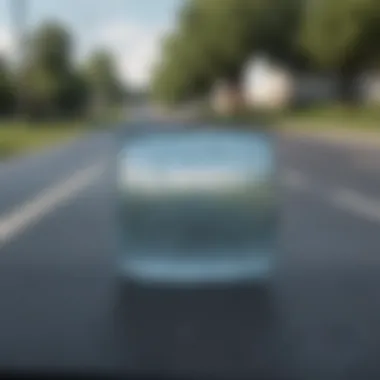Understanding Chip in Windshield Insurance: A Complete Guide


Intro
In a world where automobiles are essential, windshield integrity is paramount. For most drivers, a chip in the windshield is more than just a cosmetic issue; it can impact safety and insurance premiums. Recognizing the intricacies of chip in windshield insurance helps vehicle owners make informed decisions. Coverage options can vary significantly and monetary implications may extend beyond initial thoughts on repairs. This article serves as a comprehensive guide, opening avenues for clearer understanding.
Overview of Insurance and Credit Card Options
When exploring chip insurance coverage, it's crucial to first understand the types of insurance products available. Different insurers offer varying levels of protection related to windshield chips and cracks. Moreover, credit card benefits often complement these policies, providing additional options to vehicle owners.
Types of Insurance Products
- Comprehensive Insurance - This type generally covers damages from incidents other than collisions, specifically relating to environmental damage like rocks hitting the windshield.
- Full Glass Coverage - Specifically designed for scenarios where glass is damaged, this option typically allows for repairs or replacements without deductibles, offering an alluring safety net.
- Liability Insurance - While primarily meant for bodily injury and property damage caused by the insured vehicle, comprehensive plans may include minimal protection for windshields that are affected during an accident.
Each of these types of insurance possesses unique attributes and costs that can factor into the overall decision-making process.
Credit Card Categories
Some credit card providers offer benefits covering windshield repairs directly:
- Rewards Cards - Some rewards cards may provide cash back for repairs.
- Travel Insurance Provision - A few cards provide ancillary covers for windscreens, under longer-term travel insurances.
Matching a credit card’s feature to personal driving habits and insurance choices may provide beneficial options.
Comparative Analysis
Understanding the differences between insurance plans is essential for optimal choices concerning chip in windshield insurance. An adequate comparison enables informed evaluations.
Comparison of Insurance Plans
When examining different insurance plans, consider aspects such as:
- Deductibles - Plans with lower deductibles tend to come with higher premium costs.
- Claim Efficiency - Some insurers simplify filing processes making faster repairs a priority, which can be crucial.
- Customer Service Reviews - It's wise to gauge user satisfaction before tying down a choice.
Credit Card Comparison
Analyzing credit card benefits requires similar scrutiny. Determine:
- Cash Back Returns - Establish if rewards justify annual fees.
- Coverage Limits - Examine repair costs that won't exceed reimbursable limits.
- Accessibility - Review how easy it is to claim these rewards when needed.
Expert Insights and Recommendations
Gaining knowledge about windshield insurance and related cover feiciltates smarter decisions, especially when influenced by industry insights.
Industry Expert Opinions
Insurance experts recommend reviewing comprehensive coverage every few years. This ensures shield against evolving risks. Car Andrew, an insurance advisor, states, “Thorough understanding of polices leads to smarter purchases.”
Data-Backed Recommendations
Statistics indicate that drivers repair windshield chips directly can save around $900 annually in premium increases.
Strategies for Financial Decisions
Navigating financial aspects while ensuring optimal insurance coverage contributes long-term savings.
How to Choose the Right Insurance
Factors worthy of review involve considering vehicle age, prevalent road conditions, and individual budgets for repairs versus premiums. Many advise choosing full glass coverage as a baseline.
Maximizing Credit Card Potential
Tracking repairs and expenditures offers potential for better financial management. Choose credit cards yielding return on such services consistently to add value through careful spending.
Resources for Additional Learning


For those wanting more profound education on this topic, several tools may aid:
- Tools and Calculators: Websites and applications help calculate costs versus benefits of insurance policies.
- Further Reading and Educational Material: Resources like Wikipedia's Auto insurance offer transparency in related knowledge, enabling profound understanding and optimal decisions.
Prolusion to Windshield Damage
Windshields play a crucial role in vehicle safety and structural integrity. Understanding windshield damage is important not just for safe driving, but also for navigating the complexities of auto insurance. Windshield problems can lead to serious issues if ignored. This section examines typical types of damage and common causes of chips.
Types of Windshield Damage
Windshield damage can occur in several forms. The most prevalent types include:
- Chips: Small indentations or breaks caused often by debris like stones.
- Cracks: Breaks that can extend across the glass. These vary in length and may be caused by stress or structural imperfections.
- Pitting: Tiny, shallow marks that are typically the result of long-term exposure to the elements and debris.
- Bolts and Scratches: Although not always dangerous, they can obstruct vision and reduce the glass's integrity.
Each type presents its challenges for repair and insurance coverage. Rarely, some drivers might overlook minor damage; however, acknowledging and understanding these various forms keeps both visibility and safety maximized.
Common Causes of Chips
Despite modern technologies that enhance auto glass resilience, windshield chips remain common. These come from various sources and situations. Here are some typical causes:
- Debris from the road: Stones and gravel kicked up by vehicles can easily create chips.
- Poor road condition: Potholes or uneven surfaces can lead to excessive vibration, prompting chips and cracks.
- Weather conditions: Intense heat changes can cause existing imperfections to expand, creating further damage.
- Accidental impacts: Other objects hitting the windshield can result in immediate chips.
Awareness of these causes can lead to preventive measures. Taking special care when driving through construction zones or ensuring the vehicle is parked away from trees can significantly help.
Repairing minor damage early can save substantial costs and effort in the future, highlighting the necessity of practical awareness in windscreen care.
Insurance Overview
Understanding the framework of insurance is fundamental when addressing chip damage in windshields. This section elaborates on the critical elements that compose auto insurance policies, particularly as they relate to windshield repair and replacement. Insurance provides more than just protection from financial loss; it serves as a safety net in unforeseen circumstances. Knowing how auto insurance works empowers individuals to make smarter decisions about their coverage.
Windshield chips can occur unexpectedly. Understanding what insurance covers is crucial for timely repairs and proper maintenance of one’s vehicle. Lack of immediate action can lead to larger issues, incurring greater costs. A sound insurance policy can alleviate financial burdens, thus ensuring that necessary repairs are not neglectd.
Understanding Auto Insurance Basics
Auto insurance is a contract between the policyholder and the insurance company. In this agreement, the policyholder pays a premium, and in return, the insurance company provides financial protection against various forms of loss related to the vehicle. The terms can vary greatly, and one must be familiar with its components.
There are essentially six types of coverage, but among these the most relevant for windshield damage includes:
- Liability Coverage: Covers damage to other parties in case of an accident.
- Collision Coverage: Covers damages to your vehicle, including chips or cracks resulting from accidents.
- Comprehensive Coverage: Protects against non-collision related incidents like theft, fires, and yes, even weather-related damages.
- Glass Coverage: Specifically covers repair or replacement costs for windows and windshields.
Understanding these coverage aspects will enable vehicle owners to negotiate suitable plans tailored to their unique circumstances.
Types of Coverage Relevant to Windshields
When discussing windshield coverage, clarity is critical. Not all policies cover chip repairs equally. Here are considerations that impact coverage for windshield damage:
- Full Glass Coverage: A policy element that provides extensive replacement or repair options without a deductible for small chips or crackls.
- Deductibles: Assessing the deductibles associated with glass coverage. Some policies define coverage with conditions based on whether the chip can be repaired or the windshield needs total replacement.
- State Laws and Regulations: Different states have varying insurance laws affecting possible coverage, which might emphasize consumer rights regarding glass repair.
Choosing the right coverage can make the difference financially and affect the car's long-term maintenance strategy. Awareness of these elements empowers consumers.
Chip in Windshield Insurance Explained
Chip in windshield insurance is a critical aspect in the realm of auto insurance, targeting one specific type of road liability: windshield damage. Windshields are often seen as a secondary concern when it comes to vehicle maintenance, however, they play a pivotal role in both safety and structural support of your car. Understanding this insurance can not only provide peace of mind, but it also ensures that you are prepared should an unfortunate event arise.
Defining Chip in Windshield Insurance
Chip in windshield insurance specifically refers to the coverage designed for dealing with minor damages to the windshield. These chips are typically caused by small debris, such as stones or gravel, that is thrown up from the road and strikes your windshield. It’s crucial to differentiate this from broader auto insurance policies, which may not necessarily encompass the types of repairs that you may encounter. When included in your policy, this specific coverage ensures that damage is identified and resolved quickly and affordably, often without requiring a deductible.
In many cases, policies across different providers treat windshield chip coverage separately. For instance, some insurers, like GEICO or State Farm, have illustrated provisions within their auto insurance that detail exactly how these alterations may incur cost savings to you, should you proceed with repairs to minor chips rather than full replacements. A nuanced approach to these definitions empowers consumers to better understand what to expect when purchasing—or potentially redeeming—a claim on their insurance.
Benefits of Having Chip Coverage
Having chip in windshield insurance offers numerous benefits which can significantly mitigate damage costs and enhance overall vehicle safety. The primary benefits include:


- Cost Efficiency: Repairing small chips typically costs less than replacing the entire windshield. Having this coverage allows one to capitalize on these economic advantages.
- Quick Repairs: Insurance that specifically covers chips often allows for rapid repair processes, which can be handled at various service centers to promptly restore windshield integrity.
- Deductible Waiver: Some insurance policies will waive deductibles for windshield repairs, meaning you can address vegetation issues with no out-of-pocket expenses.
- Preserving Vehicle Value: A well-maintained windshield prevents larger issues from arising. Addressing chips can enhance not just safety, but also the resale value of your vehicle in the long run.
“Being proactive with minor chips can ultimately save you headaches and financial burdens later on.”
Overall, integrating chip in windshield insurance into your auto insurance strategy underlines not only an awareness of the kinds of damage that can occur but reflects a comprehensive approach to financial planning relating to vehicle ownership. Young professionals, families, and students should find these insights lead to better-informed insurance decisions. Ultimately, coverage for these minor damages can lead to greater customer satisfaction in a frequently overlooked area of auto insurance.
Claim Process for Chip Damage
Understanding how to file a claim for chip damage on your windshield is critical for efficient handling of the issue. With the right knowledge, you can navigate the potentially complex claims process, reducing stress and ensuring timely resolutions. The steps involved in filing a claim significantly impact your overall satisfaction with your insurance experience. Being prepared allows you to mitigate possible costs and maximize the coverage offered by your plan.
Steps to File a Claim
Filing a claim due to a chip in your windshield typically involves a few straightforward steps. First, assess the extent of the damage. If the chip is small and repairable, it might be easier and quicker to address. Here are the main steps to take:
- Notify Insurer: Contact your insurance company soon after detecting the chip. Find their customer service number or access their mobile app, if applicable.
- Document Damage: Take clear photos of the chip. This documentation may be essential for your claim. Make sure to include images that show the size and location of the damage.
- Gather Information: Have your policy number ready. Provide all required personal information to speed up the process.
- Review Coverage: Before you proceed, familiarize yourself with your insurance coverage regarding windshield repair and replacement.
- Fill Out Forms: Follow guidelines from your insurer. This usually includes filling out claim forms either online or in physical format.
Once you complete these steps, you should receive confirmation from your insurer regarding the claim submission.
What to Expect After Filing
After filing your claim, patience is often necessary. The claims process can take a variable timeframe based on provider policies. Typically, you can expect:
- Acknowledgment: Your insurer should confirm receipt of your claim. This might come through a voicemail, email, or via text message.
- Claim Review: Once submitted, an insurance adjuster may contact you to discuss the damages. They review the pictures and relevant details fully.
- Repair or Replacement Process: Depending on their assessment, the insurer may approve repairs right away or might recommend replacing your windshield.
For urgent matters, many providers partner with repair shops, allowing for quicker inspections, streamlining your experience further.
Common Pitfalls in the Claims Process
The claims process is not without its challenges. Being aware of common pitfalls can lead you to better navigational decisions:
- Ignoring Policy Details: It can be easy to overlook relevant specifics in your coverage. Always pay attention to deductibles and limits related to windshield damage.
- Delay in Reporting Damage: Some policies may enforce strict reporting timelines. Failing to notify insurers promptly may complicate your claim.
- Incomplete Documentation: Incomplete photo evidence or insufficient information can hinder your claim. Provide a comprehensive overview of the damage.
- Assuming Coverage: Avoid assumptions regarding what your policy covers. Always confirm directly with your insurer to understand coverage options fully.
Understanding these facets of the claims process is vital. Knowledge equips you to avoid errors, allowing for the efficient management of your claims for chip damage in a timely manner.
Cost Implications
Cost implications are a pivotal factor when evaluating chip in windshield insurance. Understanding the financial considerations can significantly inform choices about coverage options. Not only does this section explore how premiums are calculated, but it also weighs options between repair and replacement, alongside the value of preventive maintenance strategies.
Analyzing Insurance Premiums for Chip Coverage
Insurance premiums for chip coverage can vary widely based on factors including the insurer, model of the car, and drivers history. Premiums inherently reflect risk; the more claims a driver has filed in the past, the higher their premiums are likely to be. Additionally, geographic location plays a role. For instance, areas experiencing harsh weather conditions may see higher rates due to increased risk of windshield damage.
Moreover, it’s essential to carefully review each related policy. Many providers offer specific policies or endorsements dedicated to glass repair that may benefit drivers with shifting premium rates based on claims.
- Check your insurance provider for specific rates and packages.
- Compare several options to understand the budgeting landscape.
- Be mindful of deductibles, as they can factor into overall costs.
Comparative Costs of Repair vs.
Replacement
When faced with a windshield chip, drivers often contemplate if they should repair the damage or opt for a full replacement. The typical repair cost can range from $50 to $150, whereas replacement costs can reach up to $1,000 or more, depending on the vehicle make and model.
Key Points to Consider:
- Repair: Repairs take less time and generally salvaged the existing glass, making it faster and less costly than replacement. In many cases, insurance may cover repairs without a deductible if a specific coverage is held.
- Replacement: If the chip is extensive or causes visibility issues, replacing the windshield is necessary for both safety and compliance with insurance laws.
Knowing which option to take may depend significantly on the insurer’s coverage and the damage severity.
It is advisable to get multiple estimates from certified professionals for both repairs and replacements.
Financial Benefits of Preventive Maintenance
Proactive maintenance translates to long-term savings. Minor chips, if left unattended, can expand into larger cracks, ultimately requiring replacement, which is far more costly. Ensuring prompt repair can mitigate rising expenses along with preserving vehicle safety.


Consider These Preventive Practices:
- Regularly inspect your windshield for any signs of chips or cracks.
- Keep your windshield clean to minimize the chance of damage from flying debris.
- Address minor cracks immediately. Dealing with small issues can often prevent larger, costlier problems.
Maintaining awareness about windshield integrity will not only help in keeping car repair costs lower but can enhance driving safety too. Taking these steps will fortify the asset that is a vehicle while remaining fiscally sound in case of unforeseen damage.
Frequently Asked Questions
Understanding chip in windshield insurance can prompt many inquiries. This section provides clarity and addresses common concerns that arise when considering coverage for windshield damage. These questions not only help in demystifying policies but also guide readers in making informed decisions. Knowing the answers can ultimately prevent mishaps and unmet auto coverage expectations.
What Happens If Don't Have Coverage?
Lack of coverage for chipped windshields can spell financial burden in case of damage. Without insurance, vehicle owners face the full brunt of repair or replacement costs, which can be quite high. Repairing a chip may costs around $50–$100, which seems manageable, but if the damage worsens, a complete windshield replacement can range from $200 to over $1,000. Additionally, many people underestimate how often their windshields can be subjected to damage, leading to an even larger financial impact in the long term.
In contexts where the driver faces auto incidents, being without coverage places their entire financial risk on the individual instead of pooling it among a larger group. Ultimately, without understanding this facet of one's insurance policy, a vehicle owner may risk unforeseen out-of-pocket expenditures for something that might have been preemptively covered under a well-informed, strategic insurance plan.
Is Windshield Repair Covered Differently Than Replacement?
Yes, coverage for windshield repair often differs from that for replacement. Many insurance policies focus on offering more adequate protection for quick repairs compared to full replacements. Typically, if the damage can be sufficently repaired without compromising the structural integrity, many insurers will approve a repair at little or no cost to the policyholder. Such approvals sometimes reduce potential future uncertainties connected with claims and bolster faster service.
However, when damage is severe enough to warrant a full replacement, claims procedures may implicate different terms. Some policies could impose deductibles or may feature limitations based on claim frequency. It becomes essential for policyholders to discern these stipulations, since they can lead to significant financial variability based on minor changes in damage intensity.
How Does One Choose the Right Insurance for Windshield Damage?
Selecting the correct insurance involves evaluating numerous factors that fit an individual’s circumstances. Key aspects to consider include but are not limited to:
- Claims Process: Look for insurance companies known for a smooth claims process, especially for windshield repair.
- Coverage Limits: Review how much is covered for both repairs and replacements.
- Premium Costs: Balance the premium payments with the potential benefits in helping one manage overall repair costs.
- Customer Reviews: Consult options available on forums such as Reddit or comprehensive reviews on informational sites to gauge user satisfaction.
Compare available policies and ensure to ask specific questions about what is included. Understanding varied coverage options ensures that individuals remain informed. It ultimately aids in safeguarding their financial interests ahead of potential liabilities.
Insight: Often, discussing with an insurance broker can further clarify individual insurance choices, ensuring policies align closely with personal needs.
Common Misconceptions
Understanding common misconceptions regarding chip in windshield insurance is crucial for any car owner. Many individuals make judgments based on incomplete information, which can lead to financial misunderstandings and missed opportunities for coverage. It’s essential to clarify these myths to ensure consumers make informed decisions when it comes to their insurance policies. By dispelling incorrect beliefs, readers can better navigate their options for car insurance specifically concerning windshield maintenance.
Myth: All Insurance Policies Automatically Cover Chips
This myth often leads people to believe that they do not need to worry about the specifics of their insurance coverage regarding windshield chips. The reality is that not every policy includes coverage for windshield damage by default. Many standard auto insurance policies may exclude chips and cracks unless specific optional coverage is added. Therefore, policyholders should not assume that their protection plan is comprehensive when it comes to minor damages like windshield chips.
- Different policies offer varying degrees: Some policies may only cover full replacements, while others might include repair options. It's imperative to carefully review policy documents or consult with an insurance agent.
- Regional variances: Insurance regulations can differ significantly between states or countries. Moreover, some regions might place more emphasis on comprehensive plans covering windshield issues.
Being proactive in understanding your policy can save significant resources later on.
Important Note: Always read your policy or discuss with your insurance provider to know exactly what protections you have regarding windshield chips.
Myth: Chip Repairs Void Insurance
Another common misconception is that repairing a chip results in losing one's insurance coverage. This idea has arisen from a fundamental misunderstanding of how auto insurance policies work. Having a chip repaired will not cancel your insurance or void coverage. In fact, many insurance companies strongly encourage these repairs for common damages as they can prevent deeper cracks and more expensive damage.
- Repairs vs. Replacements: Transparent repairs typically cost less than windshield replacements. So insurers often view repairs as investments. If left alone, chips might worsen, potentially increasing the overall vehicle's risk which may lead to higher premiums later.
- No adverse effects: Since most insurance policies allow for chip repairs without penalizing policy holders, it is essential to address this myth carefully and reduce fears surrounding proactive maintenance.
Taking care of chips early could lead to less hassle with bigger claims in the future. Understanding these misconceptions regarding chip repairs can help automobile owners protect their vehicles significantly better.
Closure
In summary, understanding chip in windshield insurance is crucial for any vehicle owner. This article highlights several key aspects important for making informed decisions. Knowing the insurance options for chips is a vital part of managing your car’s upkeep. The benefits of specific chip coverage can vastly outweigh the costs of not having it.
Recap of Key Points on Chip Insurance
- **Types of Coverage: ** It is necessary to distinguish between comprehensive coverage and basic policies when talking of chip coverage.
- **Claim Process: ** Surfacing clear steps on filing a claim helps in minimizing stress during unfortunate incidents. Always keep documentation handy.
- **Cost-Analysis: ** Evaluating the cost of chip repair versus the prospective costs to replace a windshield provides clarity in financial planning.
- **Myths vs. Reality: ** Many misunderstand the nuances of what various policies cover regarding windshield alarms and repairs. Awareness is key.
- **Maintenance value: ** Some preventive actions exist to lower the risk of severe damage to windshield glasses.
By dissecting these core areas, vehicle owners will be better equipped to protect their investments.
Final Thoughts on Windshield Maintenance
Keeping a simple and regular maintenance schedule goes a long way for any vehicle.
- Regular checks can often alleviate small chips before they become major problems.
- Utilizing safe products for cleaning minimizes any invasive reactions that harsh chemicals may cause.
Investing in protective measures not just shields one from other drivers but contributes to a clear line of vision. Proper upkeeping allows for assurance of longer windshield life, distinctive benefits under insurance claims, and ultimately enhances road safety for everyone. Planning maintenance can save time, money, and plenty of stress down the road.







